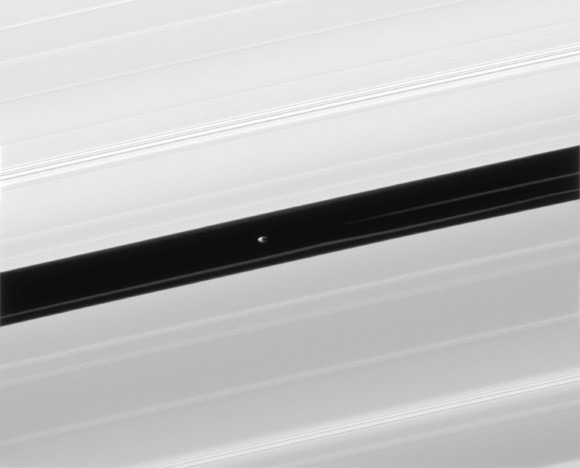Saturn’s flying saucer-shaped moon Pan, also known as Saturn XVIII, is seen in this stunning image from NASA’s Cassini spacecraft as it sweeps through the Encke Gap in the gas giant’s A ring.

This image from NASA’s Cassini robotic spacecraft shows Saturn’s A ring and its small moon Pan. Image credit: NASA / JPL / Space Science Institute.
Pan, the second-innermost moon of Saturn, was discovered in 1990 by Dr. Mark Showalter of the SETI Institute using images from NASA’s Voyager 2 spacecraft.
The tiny moon was likely formed at the same time as the giant planet’s distinctive rings.
It has a mean radius of 8.8 miles (14.1 km) and a distinctive shape similar to that of a flying saucer.
It orbits Saturn once every 13.8 hours at an average distance of 83,000 miles (134,000 km), within the Encke Gap of Saturn’s A-ring.
Pan and small moons like it have profound effects on Saturn’s rings. The effects can range from clearing gaps, to creating new ringlets, to raising vertical waves that rise above and below the ring plane.
All of these effects, produced by gravity, are seen in this image.
Pan, seen in image center, maintains the Encke Gap in which it orbits, but it also helps create and shape the narrow ringlets that appear in the Gap.
Two faint ringlets are visible in this image, below and to the right of Pan.
Many Saturn’s moons create waves at distant points in the gas giant’s rings where ring particles and the moons have orbital resonances.
Many such waves are visible here as narrow groupings of brighter and darker bands.
Studying these waves can provide information on local ring conditions.
The image of Pan was taken in visible light with Cassini’s narrow-angle camera on April 3, 2016.
The view was obtained at a distance of 232,000 miles (373,000 km) from Saturn and at a Sun-Saturn-spacecraft, or phase, angle of 140 degrees.








